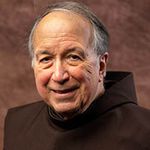Feast of the Stigmata of Saint Francis

On September 17, Franciscans celebrate the Feast of the Stigmata of St. Francis, to recall Francis's body being marked with the wounds of Christ.
What happened in LaVerna?
A modern biographer, Andre Vauchez, says: "What happened on La Verna on an undetermined day in September 1224?. . . It is difficult to say with any precision, as Francis [himself] did not mention it in his writings, and he forbade from speaking about it those rare persons who came to observe the traces of the wounds. It is thus only after his death and before his burial that a certain number of witnesses were able to actually see them on his flesh."

St. Francis Receiving the Stigmata, El Greco (1586-1600, Walters Art Gallery, Baltimore. El Greco was a Secular Franciscan and the Stigmata one of his favorite subjects.
Francis identifies with the suffering Christ
Whatever the source of the physical wounds, however, they marked a profound interior—Francis came to understand that his experience of God would reach its fullness only through his own identification with the compassionate suffering of Christ.

The chapel of the Stigmata at the sanctuary of LaVerna, built in 1263 on the spot where it was said that Francis received the wounds of Christ. The massive terra cotta image of the Crucifixion by Andrea della Robbia dates from the 1480s. Every day at 3 pm the friar community goes in procession from the church to this chapel for prayers, accompanied by pilgrims who are present.
St. Bonaventure’s interpretation of the Stigmata
The eloquent theological interpretation of the Stigmata provided by St. Bonaventure in the 1260s, based on the 1229 account of the first "Life of Saint Francis" by Thomas of Celano, became classic in the Franciscan tradition:
Two years before he returned his spirit to heaven, Francis began a forty day fast. . . in a high place apart called Mount Laverna. . . While he was praying one morning on the mountainside around the Feast of the Exaltation of the Holy Cross, he saw the likeness of a Seraph, which had six fiery and glittering wings, descending from the grandeur of heaven. . . to a spot in the air near to the man of God. The Seraph not only appeared to have wings but also to be crucified. His hands and feet were extended and fastened to a cross. . . . Seeing this, Francis was overwhelmed. His mind flooded with a mixture of joy and sorrow. He experienced an incomparable joy in the gracious way Christ appeared to him so wonderful and intimate, while the deplorable sight of being fastened to a cross pierced his soul with the sword of compassionate sorrow. He understood . . . that such a vision had been presented to his sight, that he might learn in advance that he had to be transformed totally, not by a martyrdom of the flesh but by the enkindling of his soul, into the manifest likeness of Christ Jesus crucified. The vision. . . inflamed him interiorly with a seraphic ardor and marked his flesh exteriorly with a likeness conformed to the Crucified; it was as if the liquefying power of fire preceded the impression of the seal. . . . the likeness of the Crucified in his side as well as in his hands and feet. . . . And so the angelic man, Francis, came down from the mountain bearing the likeness of the Crucified, depicted not on tablets of stone or on panels of wood, but engraved on parts of his flesh by the finger of the living God. (Bonaventure, Minor Legend, 6)
Becoming another Christ
In Bonaventure's view Francis became another Christ, not only because of the marks of Stigmata but because of the way he related to other people and creation. Francis became a person of mercy, reconciliation, and peace, and he did so by allowing himself to be fully grasped by the compassionate love of the crucified Christ. For the sake of love he spared nothing and gave everything he had to the one he loved. (Ilia Delio, Franciscan Prayer).
Learn more
LaVerna remains a place of prayer and retreat today https://www.youtube.com/embed/cPDrizA-m_0

View of the rugged mountainside of Mount LaVerna on which the sanctuary of the Stigmata stands (Photo, Mattana, Wikimedia Commons)
Dominic Monti, OFM
Professor of Franciscan Research in the Franciscan Institute of St. Bonaventure University
Dominic V. Monti, OFM, is a Franciscan Friar of Holy Name Province (USA) and currently professor of Franciscan Research in the Franciscan Institute of St. Bonaventure University. He devoted the greater part of his ministry to teaching the History of Christianity, in particular the history of the Franciscan movement. He has contributed two volumes to the Works of St. Bonaventure series and is author of Francis & His Brothers, a popular history of the Friars Minor.

